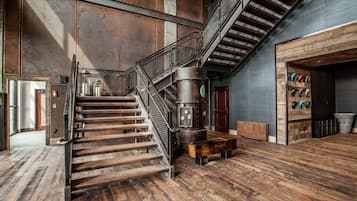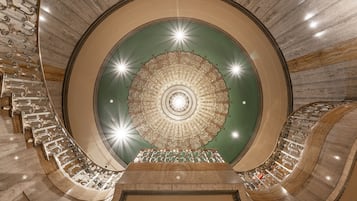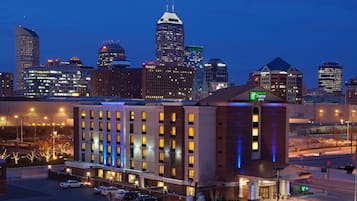Our Indianapolis Travel Essentials lays out the essential information you need to help you plan your trip to one of the most popular destinations in Indiana, USA. No matter how frequently you travel, some questions will always need answers: What’s the weather like? How can I get from Indianapolis International Airport to my hotel? What currency and type of plug do I need?
We have all these answers plus other basic info about the best time to go, getting there, getting around, and a few useful travel tips. You’ll also learn about the most popular landmarks in Indianapolis such as the Indianapolis Motor Speedway Museum, the Monument Circle, and the Scottish Rite Cathedral. It’s all compiled in this Indianapolis Travel Essentials. After going through this short and easy-to-read guide, you’ll be a little more prepared to start your trip to Indianapolis.
When is the best time to travel to Indianapolis?

- Indianapolis has a continental climate with long and humid summers and short, cold and snowy winters. Temperatures range from 22°F in winter (December–March) to 85°F in summer (May–September).
- You can expect a snowfall between November and March in Indianapolis. January is the coldest month, with the most snow and when temperatures can drop to 19.9°F. February is the driest month of the year while July is the wettest, with frequent thunderstorms.
- June–August are the warmest months, with average summer highs of 86° F. These summer months are also the peak season in Indianapolis, with more crowds and usually higher accommodations rates.
- The best time to visit Indianapolis is from June to September, when the weather is warm and pleasant for most outdoor activities. Even so, the autumn months from September to December often draw crowds with peak foliage time in October.
Indianapolis basics

- Plug type: A and B
- Electricity: 120 V
- Currency: United States Dollar (U.S.$)
- International dialing code: +1 463
- Emergency telephone number: 911
See also
- 10 Local Shopping Spots in Indianapolis

10 Local Shopping Spots in Indianapolis
United States of America - 10 Best Things to Do After Dinner in Indianapolis

10 Best Things to Do After Dinner in Indianapolis
United States of America - 6 Best Family Things to Do in Indianapolis

6 Best Family Things to Do in Indianapolis
United States of America
How to get to my hotel in Indianapolis?

Indianapolis is the capital of the state of Indiana, whose motto is the “Intersection of America”. This is due to it being at the intersection of several major Interstate Highways, namely 65, 69, 70, and 74. This means it’s easily reachable on road trips from nearby cities if you’re in the States. Most international travelers fly into Indianapolis International Airport, the city’s primary gateway, which lies about 13 miles southwest of Mile Square or Downtown.
You can also get to Indianapolis by train or bus. Amtrak serves Indianapolis as one of its major intermediate stops along its long-distance, heavy-rail Cardinal route that runs between New York and Chicago. Greyhound buses from all across the country arrive in their dozens daily at Indianapolis Union Station.
Indianapolis International Airport (IND)
Indianapolis International Airport is the main international gateway to Indiana’s capital city. You can enjoy fast and free public Wi-Fi at IND.
From the airport, it’s a 15- to 20-minute drive northeast to the Mile Square, Downtown Indianapolis. Below are the ground transportation options available to get you to your hotel from Indianapolis International Airport:
- There are several scheduled bus services providing transportation from the airport to the Greater Indianapolis area as well as to other outlying cities such as Muncie, Bloomington, and Lafayette. The one that takes you downtown is IndyGo, run by the Indianapolis Public Transportation Corporation.
- Black Automobile shared ride and luxury towncar services are available at the Ground Transportation Center outside the terminal.
- Taxi cabs are available at the Taxi cab Station just outside the terminal’s Baggage Claim. An airport surcharge applies for all taxi cabs. To hail one, simply press the designated green button.
- You can use ridesharing services Uber and Lyft at IND. Their pick-up neighborhoods are at the Ground Transportation Center, right outside the terminal.
- If you’ve booked a hotel within about a 10-mile radius of the airport, you should check whether they also provide courtesy shuttle transfers from the airport.
- Various major automobile rental companies have stands at the Ground Transportation Center, such as Alamo, AVIS, Budget, Hertz, National, and Thrifty.
Getting to Indianapolis by Amtrak train or Greyhound bus
The modern intermodal transportation center south of the historic Union Station in Downtown Indianapolis is a grand Romanesque Revival building that dates back to 1888. This station is shared by Amtrak and various intercity bus operators. Indianapolis is one of the major intermediate stops along Amtrak’s Cardinal route. Trains come from 20 cities. Note that the station doesn’t have Wi-Fi nor ATMs.
Greyhound has buses from numerous destinations across the U.S.. Daily buses arrive in their dozens at Indianapolis Union Station. Greyhound offers 3 classes of fares, namely Economy/Coach and Economy/Coach Extra, which are nonrefundable, and Flexible fares that are. Besides Greyhound, other bus companies serving Indianapolis include OurBus, Burlington Trailways, and Megabus, whose services link Indianapolis to Chicago, Cincinnati, Louisville, Nashville, Chattanooga, and Atlanta.
How to get around Indianapolis?

Travel tips
Downtown Indianapolis, also known as the Mile Square, is very manageable on foot. For navigating the urban sprawls outside downtown, however, you’ll need to hop on the public bus system or hail a taxi cab. Indianapolis is a bike-friendly city to some degree, thanks to bike lanes that have been constructed alongside the city’s major thoroughfares.
Taking a taxi cab
Besides the Indy Airport Taxi cab (+1 317-381-1111) that’s also readily available downtown, taxi cabs in Indianapolis include the blue-orange cabs run by Indianapolis Taxi cab Service (+1 317-759-2989), the yellow cabs by Liberty Taxi cab Indianapolis (+1 317-603-8788), and the silver cabs by zTrip (+1 317-487-7777).
You can also use ride-hailing apps Lyft and Uber, with plenty of drivers readily available anywhere in the metropolitan area so you can get a ride within minutes.
Traveling by IndyGo
Indianapolis’ public bus system is known as IndyGo, overseen by the Indianapolis Public Transportation Corporation. Their buses can take you throughout the city and into some parts outside downtown. Buses run Monday–Friday from 6 am to 6 pm and Saturday–Sunday from 7 am to 4 pm.
Single fares, day passes, and even week-long fare cards are available. You can buy them online or at the Julia M. Carson Transit Center, which is the public transit hub in Indianapolis. Route maps are available on IndyGo’s website. IndyGo buses have bike racks, adding more convenience if you’re exploring the city by bike.
Renting a automobile in Indianapolis
If you want total freedom for exploring Indianapolis, renting a automobile is a practical choice. If you haven’t hired a automobile at the airport, among the notable automobile rentals in the city are Budget Automobile Rental (+1 317-260-5820), Enterprise Rent-A-Car (+1 833-315-5897), Payless Automobile Rental (+1 317-777-7337), Alamo Rent A Automobile (+1 833-315-5899), and Hertz (+1 317-405-6363).
Take note of the speed limits on highways, with 55–70 mph being the general rule. There may be no speed limit stated along the city streets, but it’s always good to keep a maximum speed of 35 mph. Most of Indianapolis is flat and you can navigate your way to various spots in the Mile Square easily. There are parking meters throughout the city that accept coins and small bills, but they're often free over the weekends.
Indiana Pacers Bikeshare
To enjoy biking adventures in Indianapolis, particularly along the Indianapolis Cultural Trail, the state of Indiana offers its own bike-sharing scheme known as Indiana Pacers Bikeshare. It has about 50 stations located on or near the Cultural Trail in downtown Indianapolis, where the bright-yellow bikes are docked. Single-ride fares and annual passes for unlimited rides are available. Simply checkout, ride and drop the bike at any station after use.
Thanks to the mostly smooth and flat terrain, Indianapolis is a great biking city and there are various bike paths available. Check out the great Indianapolis Cultural Trail, where you can explore through downtown, passing public art installations and signposts that show you the city’s history. Other trails include the Monon Trail and other greenways. There are plans to continue adding cycle routes throughout the city.
What are the main annual events in Indianapolis?

500 Festival & Indy 500
- May
- A large and highly anticipated festival leading up to the Indianapolis 500 annual motor race. It features parades, marching bands, marathons, food festivals and various other family-friendly events.
- Where: Indianapolis Motor Speedway
Indiana State Fair
- August
- The state’s annual celebration in Indianapolis, which highlights all things Indiana ranging from youth and sporting events to agricultural expos and live entertainment.
- Where: Indiana State Fairgrounds and Event Center
Symphony on the Prairie
- June–August
- A series of outdoor performances in summer presented by the Indianapolis Symphony Orchestra alongside pop artists and many special guest performers.
- Where: Conner Prairie Interactive History Park
photo by NaBUru38 (CC BY-SA 4.0) modified
What are the main landmarks in Indianapolis?

Indiana State Soldiers and Sailors Monument
Also referred to as Monument Circle, this central and historical Indianapolis landmark serves as the public gathering place for notable events such as concerts and the major Circle of Lights celebration following Thanksgiving.
Indianapolis Museum of Art
One of the oldest and largest encyclopaedic art museums in the United States, with a permanent collection that includes tens of thousands of works from across the globe.
Indianapolis Motor Speedway Museum
A museum highlighting American motor racing history, particularly the various race stories and memorabilia of the Indianapolis Motor Speedway. Plan your visit around the annual Indy 500s or other summer races.
Scottish Rite Cathedral
One of the largest Masonic lodges in the world and an eye-catching historic landmark in downtown Indianapolis. It dates back to the Roaring Twenties and features travertine marble floors and Gothic-motif wall panels.
This article includes opinions of the Go Guides editorial team. Hotels.com compensates authors for their writing appearing on this site; such compensation may include travel and other costs.
Start planning your trip
Where to stay in Indianapolis

Ironworks Hotel Indy

Omni Severin Hotel

JW Marriott Indianapolis

Marriott Indianapolis Downtown

Bottleworks Hotel

Holiday Inn Express Hotel & Suites Indianapolis Dtn-Conv Ctr by IHG

Hyatt Place Indianapolis Downtown

Embassy Suites by Hilton Indianapolis Downtown

Sheraton Indianapolis Hotel at Keystone Crossing

Wyndham Indianapolis Airport
Related stories
- 10 Local Shopping Spots in Indianapolis

10 Local Shopping Spots in Indianapolis
United States of America - 10 Best Things to Do After Dinner in Indianapolis

10 Best Things to Do After Dinner in Indianapolis
United States of America - 6 Best Family Things to Do in Indianapolis

6 Best Family Things to Do in Indianapolis
United States of America - 10 Places Where Locals Love to Eat in Indianapolis

10 Places Where Locals Love to Eat in Indianapolis
United States of America - 10 Things to Do in Indianapolis in a Day

10 Things to Do in Indianapolis in a Day
United States of America - 10 Best Things to Do in Indiana

10 Best Things to Do in Indiana
United States of America - The Outlet Collection at Riverwalk

The Outlet Collection at Riverwalk
United States of America - 10 Best Miami Beach Nightlife Experiences

10 Best Miami Beach Nightlife Experiences
United States of America
